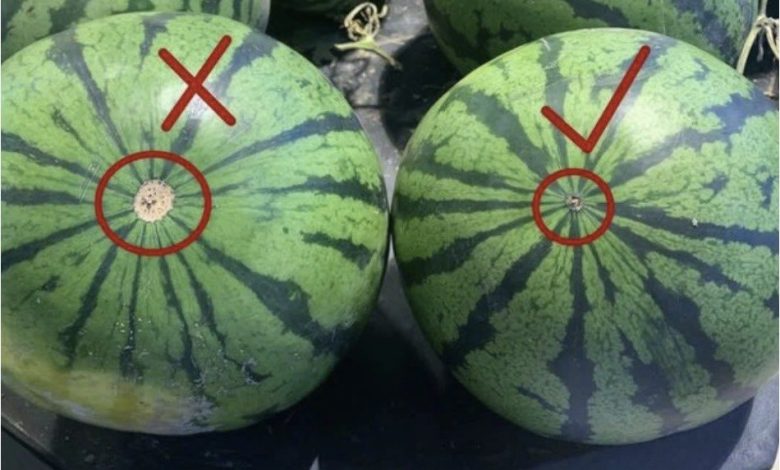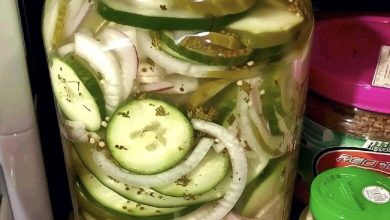
The trick to choosing a ripe watermelon with sweet, red flesh
It’s the essential fruit of summer, the one we cut into large slices when we get back from the beach, the one we enjoy in chilled cubes as an aperitif or in a vitamin-packed smoothie… But between watermelons that are too bland, underripe or soft inside, the choice can quickly turn into a headache. What if you could spot the rare gem at first glance, without even taking out your knife? It’s entirely possible… provided you know these few clues that many ignore!
The floor stain: your best visual clue
Have you ever noticed that lighter, often round, area on one side of the watermelon? This is called field spot . It forms where the fruit was resting on the ground.
If it’s creamy yellow or orange-yellow , it’s a good sign: the watermelon has ripened peacefully on the plant. On the other hand, a pale or greenish
spot indicates that it was picked too early… and may lack sugar.
Dark skin, a sign of maturity
Another clue that doesn’t lie: the texture and appearance of the skin. Dull, slightly rough skin is often a sign that the fruit is ripe.
On the contrary, a watermelon that looks very smooth and shiny is generally not yet fully ripe. Also remember to check that there are no bumps or suspicious spots: a firm and uniform skin is ideal.
The tapping test (yes, it works!)
This is a grandmother’s trick that still works very well: gently tap the fruit with your palm or fingers.
If you hear a hollow, vibrating sound , bingo! This means the flesh is juicy.
On the other hand, a dull or muffled sound could indicate that the fruit is overripe… or even mushy.
These mysterious veins are good news
Have you noticed small brownish cracks or irregular lines on the surface? Don’t worry: these marks, sometimes called veins , are often a sign of a high sugar concentration . And therefore of a very sweet and tasty fruit!
They actually demonstrate effective pollination , which promotes richness in taste.
The tail: a detail that says a lot
It’s all in the tail… of the watermelon, of course! Take a look at the stalk, that little remnant of stem often still attached to the fruit.
A brownish, dry, and curled stem is an excellent indicator of ripeness.
If it is still green, the fruit was probably harvested too early.
Weight, a key criterion (and easy to test)
Here’s a simple rule of thumb: if the watermelon is the same size, always choose the heaviest one . Why? Because that means it’s full of water . And water means freshness and juiciness!
Don’t hesitate to compare several fruits in the store: you will sometimes be surprised by the difference just by lifting them.
It’s the essential fruit of summer, the one we cut into large slices when we get back from the beach, the one we enjoy in chilled cubes as an aperitif or in a vitamin-packed smoothie… But between watermelons that are too bland, underripe or soft inside, the choice can quickly turn into a headache. What if you could spot the rare gem at first glance, without even taking out your knife? It’s entirely possible… provided you know these few clues that many ignore!
The floor stain: your best visual clue
Have you ever noticed that lighter, often round, area on one side of the watermelon? This is called field spot . It forms where the fruit was resting on the ground.
If it’s creamy yellow or orange-yellow , it’s a good sign: the watermelon has ripened peacefully on the plant. On the other hand, a pale or greenish
spot indicates that it was picked too early… and may lack sugar.
Dark skin, a sign of maturity
Another clue that doesn’t lie: the texture and appearance of the skin. Dull, slightly rough skin is often a sign that the fruit is ripe.
On the contrary, a watermelon that looks very smooth and shiny is generally not yet fully ripe. Also remember to check that there are no bumps or suspicious spots: a firm and uniform skin is ideal.
The tapping test (yes, it works!)
This is a grandmother’s trick that still works very well: gently tap the fruit with your palm or fingers.
If you hear a hollow, vibrating sound , bingo! This means the flesh is juicy.
On the other hand, a dull or muffled sound could indicate that the fruit is overripe… or even mushy.
These mysterious veins are good news
Have you noticed small brownish cracks or irregular lines on the surface? Don’t worry: these marks, sometimes called veins , are often a sign of a high sugar concentration . And therefore of a very sweet and tasty fruit!
They actually demonstrate effective pollination , which promotes richness in taste.
The tail: a detail that says a lot
It’s all in the tail… of the watermelon, of course! Take a look at the stalk, that little remnant of stem often still attached to the fruit.
A brownish, dry, and curled stem is an excellent indicator of ripeness.
If it is still green, the fruit was probably harvested too early.
Weight, a key criterion (and easy to test)
Here’s a simple rule of thumb: if the watermelon is the same size, always choose the heaviest one . Why? Because that means it’s full of water . And water means freshness and juiciness!
Don’t hesitate to compare several fruits in the store: you will sometimes be surprised by the difference just by lifting them.




